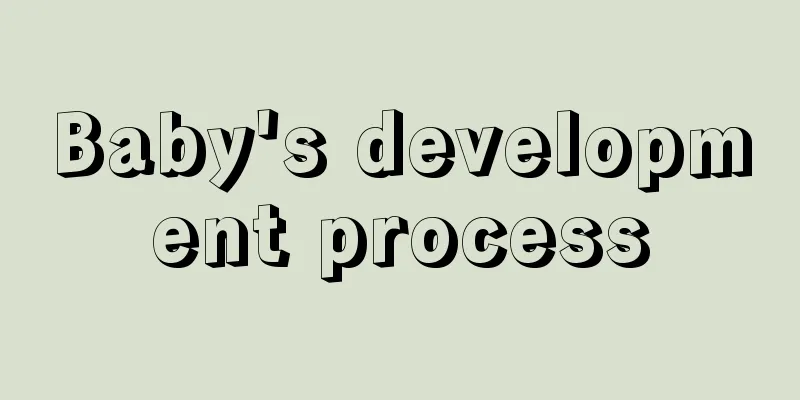Baby's development process

|
Babies have a development process from birth to the time they can walk. Parents can refer to the development process I have compiled below and hope it can give parents a reference. Babies need to pay attention to many things during the development process, and parents need to learn a lot in this process. Babies need to pay attention to diet and add clothes according to the weather. There are many things that parents need to do from the moment the baby comes into this world. 1 week baby growth and development When the doctor cuts your baby's umbilical cord, takes care of everything, and holds him (her) in your naked, warm chest, with skin contact with yours, have you temporarily forgotten the long and painful delivery process you just experienced? Will that wonderful feeling be unforgettable to you for the rest of your life: a mixture of joy, surprise, love, feeling like in a dream, as well as a bit of strangeness and a bit of helplessness. The experience of being a mother becomes real and three-dimensional, because the baby who is connected to you by blood is right in front of you, in your arms, and within reach. 2 weeks baby growth and development This week the baby is continuing to try to adapt to this new environment. For him, the outside world is noisy and bright compared to his mother's womb, which is a little unusual. But you will find that your baby is making progress every day and his adaptability is quite strong. Most babies will experience a temporary drop in weight in the first week after birth. This is because the baby eats less milk at this time, and the excretion of meconium and urine, as well as sweating from the skin and breathing, causes some body water loss. Temporary weight loss will occur 2 to 4 days after birth, which is medically called "physiological weight loss" and generally does not exceed 300 grams. As the baby's milk intake increases, his weight will start to increase from the 4th or 5th day, and will return to his birth weight within a week. You will find that the baby's limb movements are involuntary and unconscious conditioned reflexes. For example, when frightened by a loud noise, the limbs will subconsciously be pulled together towards the chest. This is the unique hugging reflex of newborns. By the end of this month, you will find that your baby's movements become conscious behaviors as his or her muscle control develops. From birth to 56 days, the baby has a magical ability - walking reflex. Starting from the 8th day after the baby is born, this innate ability can be trained. It can not only enable the baby to learn to walk early, but also promote brain maturation and intellectual development. Some babies make wheezing sounds when they breathe. This is because the blanket that the baby covers with, the lint that falls off the clothes that the baby wears, and more dust in the air block the baby's nasal cavity and upper respiratory tract. But you don't have to worry, the baby is not catching a cold. The possibility of the baby catching a cold at this time is not high. The baby is just trying hard to breathe. You can try to use a cotton swab dipped in some baby oil to help your baby remove dirt from his nasal cavity, but be gentle and be careful to hold your baby's head and don't let him shake. 3 Weeks Baby Growth and Development This week, the baby's various conditioned reflexes have been established. When you separate his (her) tightly clenched hands and touch his (her) palm with one finger, he (she) will hold your finger tightly and not let go. When the mother holds him (her) to her chest and prepares to feed, or when the baby is hungry or crying, he (she) will shake his (her) head from side to side, open his (her) little mouth, and arch his (her) head to find the mother's nipple. He (she) can already master the essentials of sucking milk very skillfully, and his (her) little mouth sucks very forcefully. When you slowly put your hand close to the baby's eyes, the baby will blink involuntarily when you are at a certain distance. Your baby will now be able to make eye contact with you, but not for long. When the baby is looking at you, you should also look at him (her) attentively, give him (her) a loving smile, nod to him (her), and gently call the baby's nickname, all of which will make the baby feel happy. The baby will not consciously touch objects now, but he (she) likes you to do massage exercises for him (her), and likes the mother's gentle touch, kind voice, and kind smile. At this time, the baby's body is still very soft. When holding him (her), you must pay attention to supporting the baby's neck, waist and hips. If your baby often cries and is irritable for unknown reasons, and no amount of coaxing works, and in severe cases, the baby may have bouts of violent crying that last for several minutes before calming down, then the baby may be suffering from colic. Generally speaking, about 20% of babies begin to show symptoms of colic 2 to 4 weeks after birth. When an attack occurs, the baby will not only cry for a long time, but also look very uncomfortable. If your baby has this phenomenon, you will probably have a hard time in the next few months, because this kind of abdominal pain is functional and will occur frequently. There is no particularly good treatment method. It will naturally get better when the baby grows up. During each attack, the baby should be placed in a prone position and the back should be gently massaged to help relieve the pain. You can also take pediatric sedatives according to the doctor's advice. The whole process of newborn baby's growth and development At this time, babies have begun to show different personality traits. Some are crybaby and active, difficult to take care of, and make their mothers exhausted; some are quiet and well-behaved, cry less often, and are especially easy to take care of. This is determined by the baby's different nervous types and temperament types. You can only adapt to the baby, and it is unlikely that you can change him easily. This will test the patience of parents. Every baby is a unique individual. We should respect the baby's personality and let it grow up happily and healthily. 4 Weeks Baby Growth and Development The baby is already 3 weeks old, and will be one month old this weekend! The birth of the baby seems to have been just yesterday, but to the mother this month has been so long. She has gone through a lot of hardships and experienced all kinds of feelings of being a first-time mother. However, seeing the baby's progress day by day, the mother feels happy in her heart no matter how hard and tired she is. Now the baby's neck strength has been strengthened. He can lie on the bed or on an adult's chest, using the abdomen as support, lift his head slightly for a while, and turn his (her) little head left and right. If you hold your baby in your arms or let him sit on you, his head can be kept upright for a while, but not for too long to avoid tiring him. The baby's arm and leg movements are also more coordinated, which means that his or her ability to control muscles has improved. Now the baby has initially formed his own sleeping, feeding and defecation patterns and habits. Some babies can sleep for 4 to 6 hours at night, but there are big differences between babies. Some babies still need their mother to feed them 2 or 3 times at night. Especially for babies who are breastfed, the intervals between feedings are short because breast milk is easier to digest. Therefore, babies who are breastfed have more bowel movements than babies who are fed milk, and they need more care from their mothers. At this time, the baby can distinguish the mother's voice and smell. Even if the mother is not around, as long as he hears the mother's voice, the baby will show excitement. If the baby is crying because of loneliness and boredom, he will quickly calm down when he hears the mother's voice. If you have done prenatal education for your baby, try playing the music or stories that he/she often listened to during the fetal period. The baby will most likely have an obvious reaction. Now the baby can determine the source of sound. When hearing sounds coming from different directions, the baby's head will turn in that direction. But the sound distance cannot be too far, it should be within 50 cm. The baby's eyes can now see people and objects at close range, and his gaze will follow the objects in front of him horizontally. He especially likes to look at pictures with thicker lines, simple patterns, and bright colors, especially patterns of human faces. Compared with the previous few weeks, the baby has made obvious progress and looks more lovable. The average weight of a one-month-old baby is 4.9 kg for boys and 4.6 kg for girls; the average height of a one-month-old baby is 56.6 cm for boys and 55.6 cm for girls. 5 Weeks Baby Growth and Development 1. Characteristics unique to newborns, such as being easily startled and having unstable limb movements, begin to gradually disappear in babies after one month. His (her) limbs and hands are already stretched out a lot more than when he (she) was born, but when he (she) sleeps, he (she) still curls up with his limbs like a little frog, and this posture will last for a long time. The baby has become accustomed to various sounds in the outside world and has begun to distinguish their sources. 2. He (she) can stare at you very intently, and will smile at you when happy. At this time, the baby will not laugh out loud, but you can already tell that he is smiling at you. Now the baby can lift his head when lying on the bed. Some babies can even stand up their head and neck for a while. But don't let the baby lie on his stomach for too long. He should lie down flat to rest after lying on his stomach for a while or standing up for a while. 3. Now when you hold a toy and move it in front of your baby, the baby's eyes can always follow the object in front of him. But what surprises parents the most is that the baby actually starts to "speak". The baby will make "hmm", "ah", "eep", and "yay" sounds to express his (her) feelings and needs. At this time, the mother must respond to the baby in time. You can imitate the baby's pronunciation to "talk" to him (her), and "talk" to the baby face to face as much as possible. Even if you walk away for a while and go to another room, you can keep talking to the baby and let the baby hear your voice, so that his (her) emotions will be much calmer. 4. The life of parents nowadays is to constantly change diapers, feed their babies, and take care of their mouths and butts. They are so busy that they cannot eat well or sleep well. Life seems not only hard but also a bit dull. What’s more serious is that some mothers will suffer from "postpartum depression" and need the help of doctors and more care from their families. Don't worry, all this is not your entire life in the future, it is just a stage in parenting life. As your baby grows up day by day, you will see that your hard work has brought about your baby's healthy growth, and you will cherish your baby more because of it. As mentioned above, I hope to give parents some reference and help everyone. Every stage of the baby is different. At a certain stage, the baby can begin to distinguish sounds and talk to the baby. She will laugh and pay attention to some sounds. The baby will have different changes every week. It is not an exaggeration to say that the baby is different every day. The baby changes at every stage and as parents, we are also constantly learning. |
<<: What should I do if my baby has anal bleeding?
>>: Is the cause of facial eczema in children complicated?
Recommend
What to do if one-year-old baby has excessive lead content
Children at the age of one have already begun to ...
What should I do if my child has blue veins on his nose?
Most children do not have very good physical fitn...
Why do children often hiccup?
Children's bodies are in the stage of develop...
Four major misunderstandings about calcium supplementation for babies
When taking care of their babies, many mothers wi...
Why does my baby have a runny nose when crying?
Whenever the baby at home cries loudly, many moth...
Are there any side effects for children taking anthelmintics?
I believe that all parents will have such trouble...
What causes a child to have a fever while teething?
Many parents and friends have recently said that ...
Massage for dry cough in children
The incidence of dry cough in children is very hi...
What to do if children are deficient in zinc and calcium
When children are deficient in calcium and zinc, ...
Is it normal for a newborn to snore?
Newborn babies are immature in all aspects, so so...
How to correct the symptoms of hunchback in children
If we want to correct our children's hunchbac...
What are the clinical manifestations of ADHD in children?
Attention Deficit Hyperactivity Disorder (ADHD) i...
Why do children often catch colds and have fevers?
Many children have poor constitutions when they a...
What to eat when baby sweats
I believe that many babies often encounter the si...
Is it good to give children an enema?
In fact, if the child can take medicine normally ...









